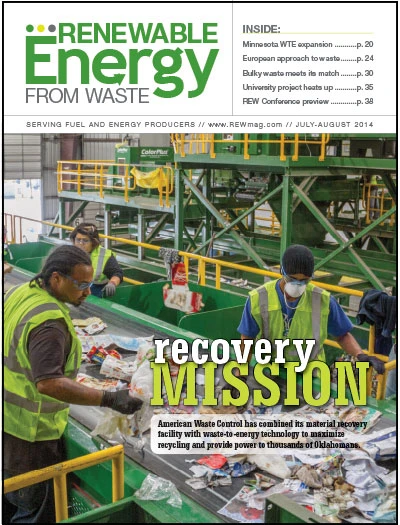 In the heart of lake country in west central Minnesota sits the town of Perham. This town of almost 3,000 residents boasts several food manufacturing industries, a Midwest work ethic and a progressive view of stewardship. The city includes a waste-to-energy (WTE) facility that converts regional garbage into energy utilized by local industries—the Perham Resource Recovery Facility (PRRF). This facility is being expanded to increase the throughput and to recover more recyclables.
In the heart of lake country in west central Minnesota sits the town of Perham. This town of almost 3,000 residents boasts several food manufacturing industries, a Midwest work ethic and a progressive view of stewardship. The city includes a waste-to-energy (WTE) facility that converts regional garbage into energy utilized by local industries—the Perham Resource Recovery Facility (PRRF). This facility is being expanded to increase the throughput and to recover more recyclables.
The expansion of the PRRF has several key elements including: the history of the plant, creation of a new organization and ownership; utilization of new technologies; benefits of municipal operations; preprocessing of municipal solid waste (MSW); and the project approach. These stories combine to create one large success story which happens to take place at a small facility in a small town in rural Minnesota.
Facility history
The original plant was commissioned in 1986 as a subsidiary of the Otter Tail Power Co. known as Quadrant. The original facility consisted of two modular combustor units with a combined exhaust that supplied a common boiler and electrostatic precipitator (ESP). The plant provided steam to a local cheese plant owned by Land O’ Lakes Dairy and continued to operate until 1998, when it was shut down due to air permit violations.
The facility was retrofitted with new combustion grates and air pollution control equipment by the former Barlow Technologies and recommissioned in 2002. The plant continues to operate today and supplies steam to two customers: Bongard’s Dairy (which purchased the cheese plant from Land O’ Lakes) and Tuffy’s Dog Food. The facility provides steam to these customers under the terms of a sales agreement that also requires that they meet all of the customers’ steam requirements, which necessitated the installation of a natural-gas-fired auxiliary boiler in 2007.
Barlow developed the combustion grate technology installed in the 2002 retrofit. The company installed combustion grates with a larger capacity than the original modular combustors. The secondary chambers were left in place along with the exhaust duct and waste-heat boiler. The new air pollution control equipment installed included a dry injection reactor for acid gas control, activated carbon injection and a fabric filter. The current capacity of the retrofitted facility is 116 tons per day (TPD), similar to the original facility and processes about 35,000 tons annually.
The city of Perham owned the facility in 2002 when the Barlow retrofit was performed. At that time, the waste was provided under agreements by the counties of Otter Tail, Todd, Wadena and Stearns. As the expansion was contemplated, it became desirable to change the ownership of the plant and the organization of the system by creating a regional authority responsible for owning, operating and supplying waste to the plant. This was the impetus for creating Prairie Lakes Municipal Solid Waste Authority (PLMSWA), created in 2010 which now includes the counties of Otter Tail, Todd, Wadena and Becker. Today, the facility is wholly owned and operated by PLMSWA.

Expansion planning
In 2006, a study was executed to consider expansion of the facility. This option was based on maximizing the design capacity of each of the combustion grates by separating the exhaust and providing a new boiler and air pollution control train for one of the grates. This would result in two completely separate combustion trains, each with a throughput of approximately 100 TPD.
The coordinating board that governed the facility did not act further on the expansion plan until 2008 when the study was updated. That same year, a grant application was submitted to the state of Minnesota to fund a portion of the expansion project. The state awarded preliminary approval of the grant in early summer 2010, and it was finalized late that year. The final plan was based on the addition of a waste-heat boiler and air pollution control train to create two separate combustion trains as described earlier, but also the addition of a front-end material recovery facility (MRF) to recover ferrous and nonferrous metals and potentially other recyclable materials prior to the combustion process.
Project execution
PLMSWA selected Renewable Resource Consultants LLC (now RRC Power and Energy), Maple Grove, Minnesota, as the Owner’s Engineer to execute this project and Wenck Associates Inc., Maple Plain, Minnesota, as the environmental permitting consultant.
The environmental permitting effort was initiated in early 2011 and continued through the issuance of final permits in March 2013. The permitting team, led by Wenck, conducted a complete and voluntary Environmental Impact Statement (EIS) to assure the PLMSWA Board and the public that all concerns were thoroughly vetted.
The project approach, recommended and coordinated by RRC, was to execute four separate contracts as follows:
- The MRF or up-front processing system was an engineer-procure-construct (EPC) agreement. RRC developed a request for qualifications (RFQ) and request for proposals (RFP) which established the design criteria and terms of the agreement. RRT Design and Construction of Melville, New York, was awarded the contract.
- The addition of a new boiler and air pollution control equipment to create two combustion lines was also an EPC agreement which was similarly procured through detailed design criteria developed by RRC. This contract was awarded to a joint venture of Casey Industrial Inc., Westminster, Colorado, and Interstates Cos., Sioux Center, Iowa, identified as Casey Interstates Partnership (CIP).
- The third contract was a conventional design-bid-build approach. RRC led the detail design team and prepared a bid package to include the building enclosures, administration areas and all site work. JP Structures, Menagha, Minnesota, (now VERCON) was awarded the contract.
- The fourth contract was awarded to Dresser-Rand, Houston, for the upgrade to the governor and control system on the existing steam turbine generator (STG).

Project status
The MRF system has been commissioned and is now being operated by PLMSWA. The buildings and site-work construction also is complete. The third contract for the WTE expansion is nearing completion and is expected to conduct acceptance testing in August 2014. Dresser-Rand will complete the STG upgrade by the end of 2014. The total project cost is detailed in the table above.
The expanded PRRF is unique in many ways. First is the scale of such a facility. Many of the conventional WTE plants operate at much larger scales in areas with higher population densities. While one may assume that there is a cost benefit at the larger scale, recent facility expansion information, shown in the table on page 22, shows a small facility can be constructed at similar costs.
The use of up-front processing to recover recyclables prior to combustion also is notable. Recovering metals and undesirables prior to combustion leads to more reliable combustor service, lower emissions and lower maintenance costs.
The WTE facility expansion also uses a new air pollution control technology provided by Bold Eco under the CIP contract to meet the emission limits of new source performance standards (NSPS) for Small Municipal Waste Combustors, Subpart AAAA. This configuration incorporates a semidry scrubber vessel into each of four fabric filter compartments. This design uses reinjection of fly ash and scrubber residue into the system to maximize pollutant capture and minimize reagent use.
Success can be defined in many ways. For the communities that make up PLMSWA, success is improving the community through an integrated approach to solid waste management. This includes following a well-established hierarchy of waste disposal options that is environmentally superior and brings economic benefit.
Matt Clark, PE, is vice president of RRC, Maple Grove, Minnesota, and can be contacted at MattClark@RRCcompanies.com. The information in this article was presented at the 2014 North American Waste-to-Energy Conference (NAWTEC).

Explore the August 2014 Issue
Check out more from this issue and find your next story to read.
Latest from Waste Today
- Rancho Las Virgenes Compost Facility—Calabasas, California
- Optimize wet waste management with Sebright Products High-Density Extruders
- Plum Creek announces new regional sales manager
- WM reports strong Q4 earnings
- Washington state legislature introduces bills to create recycling refund program for beverage containers
- Lee Zeldin sworn in as new EPA administrator
- C&D World session preview: Optimizing Plant Operations with best practices for efficiency and success
- Hyva launches new rear loader





